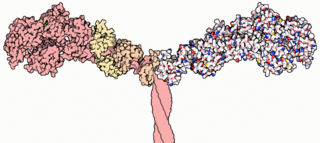
Myosins are a superfamily of motor proteins best known for their roles in muscle contraction and in a wide range of other motility processes in eukaryotes. They are ATP-dependent and responsible for actin-based motility.

Nebulin is an actin-binding protein which is localized to the thin filament of the sarcomeres in skeletal muscle. Nebulin in humans is coded for by the gene NEB. It is a very large protein and binds as many as 200 actin monomers. Because its length is proportional to thin filament length, it is believed that nebulin acts as a thin filament "ruler" and regulates thin filament length during sarcomere assembly and acts as the coats the actin filament. Other functions of nebulin, such as a role in cell signaling, remain uncertain.

Myosin VIIA is protein that in humans is encoded by the MYO7A gene. Myosin VIIA is a member of the unconventional myosin superfamily of proteins. Myosins are actin binding molecular motors that use the enzymatic conversion of ATP - ADP + inorganic phosphate (Pi) to provide the energy for movement.

Unconventional myosin-Va is a motor protein in charge of the intracellular transport of vesicles, organelles and protein complexes along the actin filaments. In humans it is coded for by the MYO5A gene.

Disabled homolog 2 is a protein that in humans is encoded by the DAB2 gene.

Unconventional myosin-VI, is a protein that in humans is coded for by MYO6. Unconventional myosin-VI is a myosin molecular motor involved in intracellular vesicle and organelle transport.

Myosin-9 also known as myosin, heavy chain 9, non-muscle or non-muscle myosin heavy chain IIa (NMMHC-IIA) is a protein which in humans is encoded by the MYH9 gene.

Disintegrin and metalloproteinase domain-containing protein 9 is an enzyme that in humans is encoded by the ADAM9 gene.

MYO9B is a gene that encodes the Myosin-IXb protein.

Ena/VASP-like protein is a member of the Ena/VASP family of proteins that in humans is encoded by the EVL gene.

Myosin-Ic is a protein that in humans is encoded by the MYO1C gene.

Myosin X, also known as MYO10, is a protein that in humans is encoded by the MYO10 gene.

Unconventional myosin-Ia is a protein that in humans is encoded by the MYO1A gene.

Myosin-Vb, a myosin V type protein, is encoded by the MYO5B gene in humans.

Myosin-IIIa is a protein that in humans is encoded by the MYO3A gene.

Myosin-Ib is a protein that in humans is encoded by the MYO1B gene.

Myosin-If is a protein that in humans is encoded by the MYO1F gene.

Myosin light chain kinase, smooth muscle also known as kinase-related protein (KRP) or telokin is an enzyme that in humans is encoded by the MYLK gene.

Myosin-XV is a protein that in humans is encoded by the MYO15A gene.

VEZT is a gene located on chromosome 12 and encodes for the protein vezatin. Vezatin is a major component of the cadherin-catenin complex that is critical to the formation and maintenance of adherens junctions. The protein is expressed in most epithelial cells and is crucial to the formation of cell-cell contact junctions. Mutations of the gene can lead to upregulation or downregulation of the protein which can have detrimental effects on physiological systems, particularly those involved in development.






















